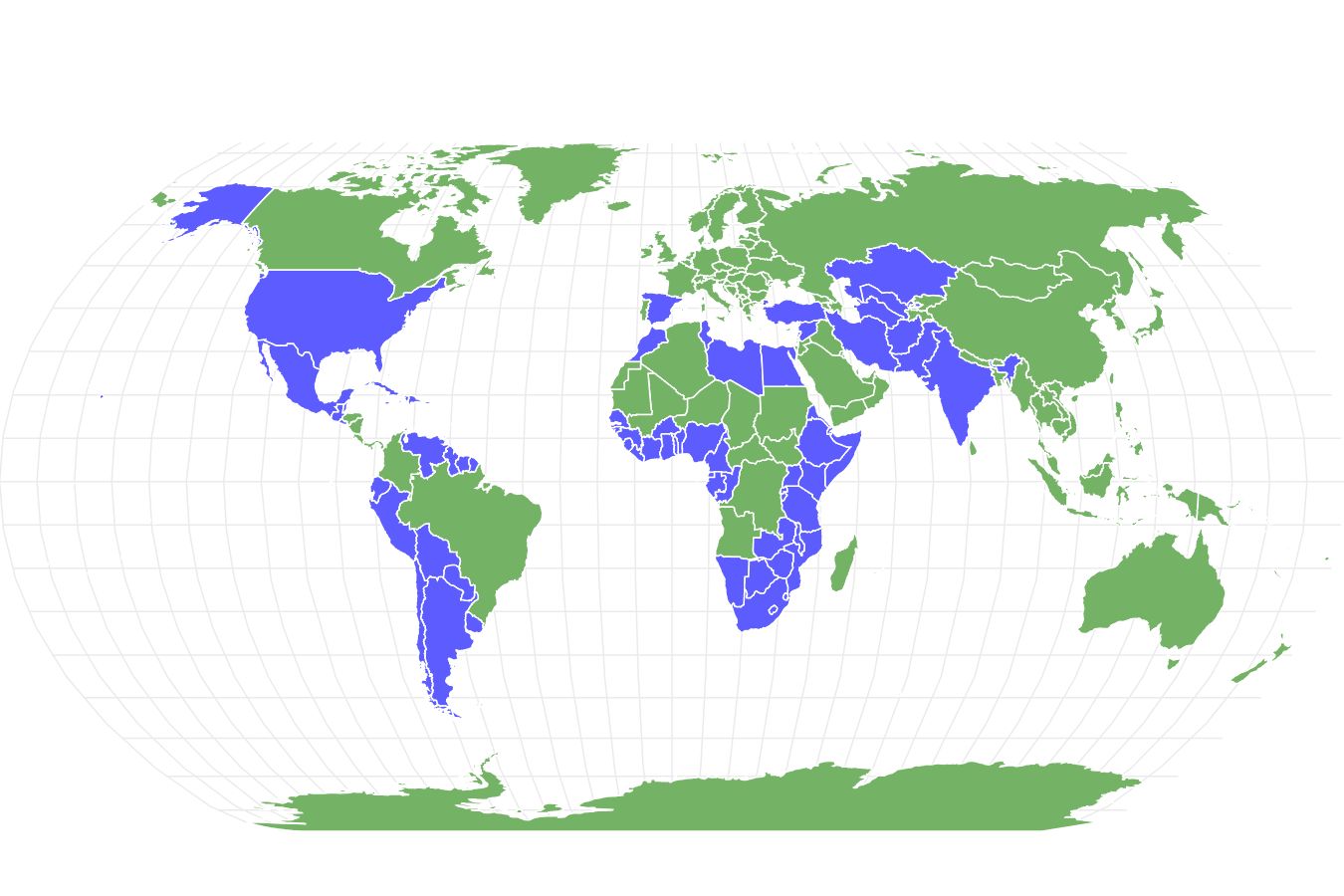Flamingo
Sleeps on just one leg!
Advertisement
Flamingo Facts
- Diet
- Omnivore
- Lifestyle
- Flock
- Favorite Food
- Algae
- Type
- Bird
- Average Clutch Size
- 1
- Slogan
- Sleeps on just one leg!
View all of the Flamingo images!
“A flamingo’s feathers don’t turn pink until it reaches 2 or 3 years old”
Flamingos are omnivorous birds that eat brine shrimp, algae, and snails. They live in large groups called colonies. These birds reside in tropical climates in regions of Africa, Asia, and around South America. This bird can have a wingspan as wide as 60 inches.
An Incredible Bird: 5 Flamingo Facts!
- Flamingos lay just one egg in a clutch.
- They have pink feathers due to the beta-carotene in the foods they eat.
- These birds can live from 20 to 30 years in the wild.
- They sometimes live in flocks containing thousands of birds.
- Their webbed feet help them to move across the surface of a lake.
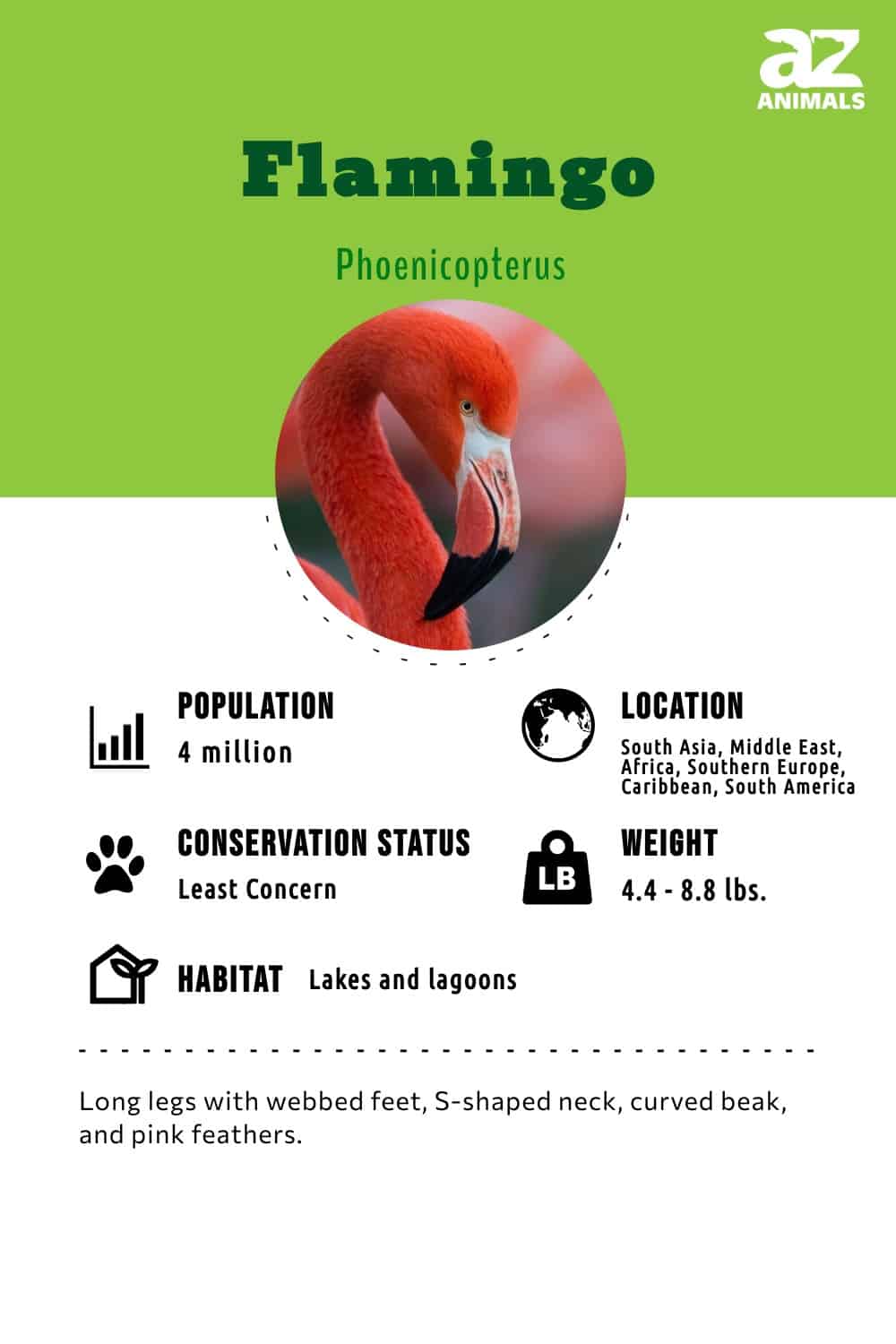
Scientific Name and Different Types
The scientific name of the American Flamingo is Phoenicopterus ruber. The word flamingo comes from the Spanish word flamenco. Flamenco is a rhythmic dance. This may refer to the behavior of a flock of flamingos as they change direction in unison and move in a synchronized way.
The other five species of flamingo include:
- Lesser Flamingo (Phoeniconaias minor) – Appropriately named, these are the smallest of the flamingos. Besides their size, they can be identified by their dark red beaks, light pink plumage, and hind toes. They live near high mountain lakes and lagoons in Peru, Chile, Bolivia, and Argentina.
- Chilean Flamingo (Phoenicopterus chilensis) – These flamingos stand out from their cousins because of their legs. They are grey with ping coloration of their leg joints. They have typical pink plumage, and their beaks are over 50% black. These birds are located in South American mudflats and shallow lakes from Peru, Bolivia, Ecuador, Brazil, Argentina, and Chile.
- Greater Flamingo (Phoenicopterus roseus) – The biggest of the flamingos, the Greater Flamingo has a white hue to its feathers. They can be spotted because of the black tip on their beaks and the pink coloration from the beak to the eye. They can be found in around the parameters of Africa, the Middle East, India, Pakistan, and southern Europe. And they will migrate if the weather is too harsh.
- Andean Flamingo (Phoenicoparrus andius) – This flamingo is pale pink, although it does have some darker upperparts and wing covers, and black flight feathers. They have brownish and reddish eyes. This particular type of flamingo can be found in lakes of the Andes mountains of South America.
- Puna Flamingo (Phoenicoparrus jamesi) – Also known as James’s Flamingo, these flamingos’ plumage is very pale and has bright streaks around their necks. Their beaks are yellow and have black tips to them. Instead of pink, the Puna Flamingo has red legs. These birds can be found in the high mountains of Chile, Argentina, Bolivia, and Peru.
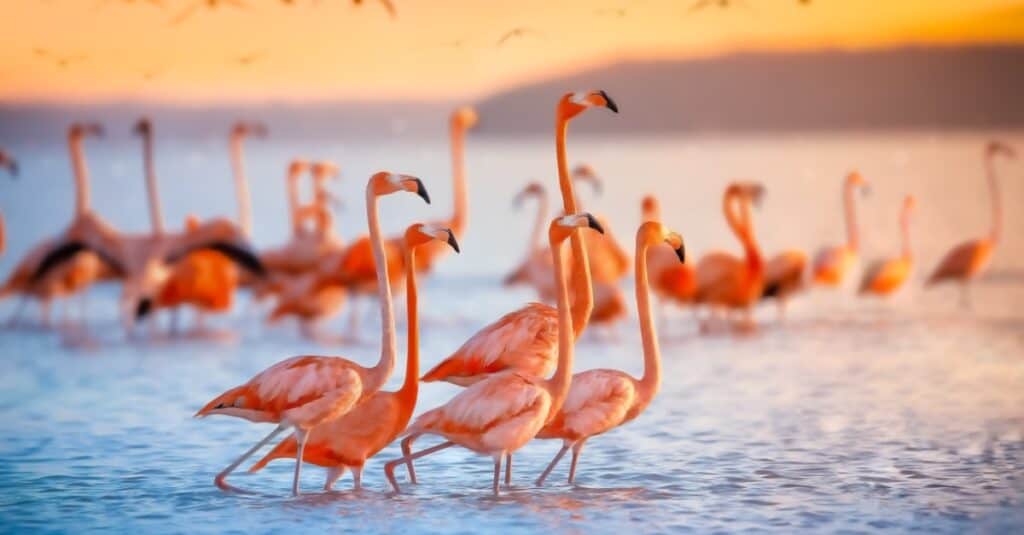
The word flamingo comes from the Spanish word flamenco, a rhythmic dance.
©iStock.com/Jonathan Ross
History and Evolution
Scientists and researchers believe that flamingos most likely evolved from Junciatarus. There was a divergence that produced the grebes and flamingos in the late Eocene period. The Junciatarus was a generalist feeder that found its food by wading through freshwater in North America and Europe. Some of their extinct cousins are thought to have had shorter legs and were more diver hunters than flyers.
It is not known exactly when the ancestors of the flamingo evolved to have their specialized filter-feeding capability because of the lack of fossil records. There is a gap of time in fossils from their predecessors and in fossils from early flamingos that would indicate a gradual adaptation of filter-feeding.
Appearance & Behavior
Flamingos are birds that are known for their long legs (with webbed feet), S-shaped neck, curved beak, and pink feathers. Their diet of algae and brine shrimp contains beta carotene which is a red/orange pigment. The large supply of beta carotene taken in via the bird’s diet is what turns their feathers bright pink. This bird uses its curved beak to shovel algae into its mouth when its head is underwater.
These birds range from 3 to 4 feet tall and can weigh up to 9 pounds, depending on the species. The tallest species is the greater flamingo at 4.7 feet as well as the heaviest at 9 pounds. Line up three bowling pins end to end, and they are equal in length to a 4-foot-tall bird. A 9-pound bird is almost as heavy as the average housecat.
The largest wingspan of the flamingo bird is 60 inches. That length is almost equal to the length of a home’s refrigerator! A Roseate spoonbill is similar to a flamingo and has a wingspan of 51 inches.
When it comes to survival, the flamingo’s greatest asset is its colony lifestyle. They live in colonies containing 100 or even thousands of birds. The sheer size of a colony can discourage predators. If one bird spots a predator, it begins honking to alert other birds of the danger.
These social birds can be aggressive to one another when looking for food or competing for a mate during the breeding season. Otherwise, they’re even-tempered animals.
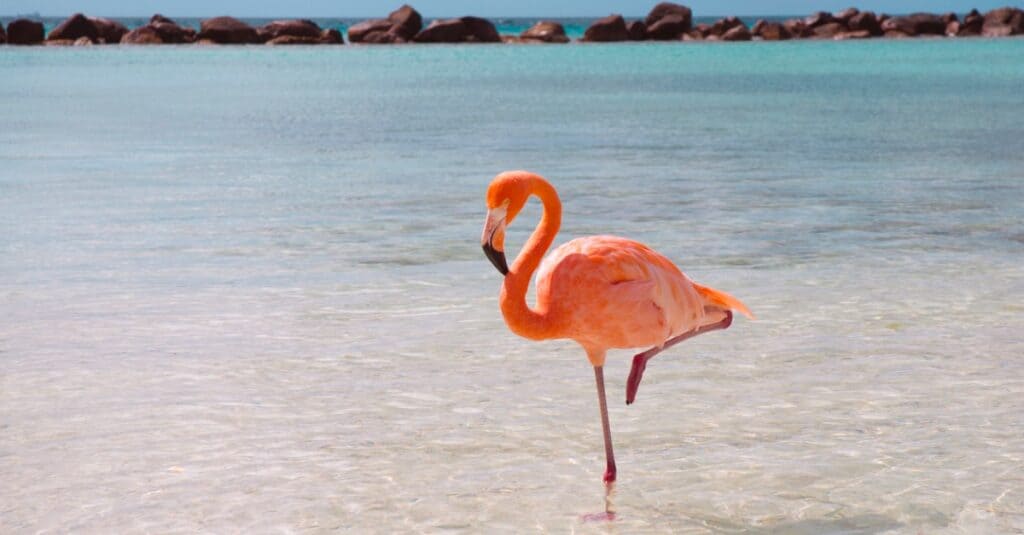
The color of a flamingo is a result of what they eat— algae and brine shrimp.
©Natalia Barsukova/Shutterstock.com
Habitat
These birds live in tropical climates. Some live in east, west, and southwestern Africa. Other species live in the southern region of coastal South America. They are also found in the Galapagos Islands, Turks and Caicos Islands, and the Bahamas as well as in India. The region of the world where a flamingo lives depends on its species.
Specifically, their habitats include lagoons, shallow lakes, mangrove swamps, and tidal flats.
Though this bird is not known to migrate, a colony may relocate if there is a drought in the area or if there is a shortage of one of its food sources. Birds living in a lake that is at a high elevation may move to a body of water at a lower elevation for the winter months.

Birds living in a lake that is at a high elevation may move to a body of water at a lower elevation for the winter months.
©iStock.com/YULIIA LAKEIENKO
Legs
The bird’s legs help it to survive in its lagoon, lake, or swamp habitat. The long legs of this animal allow it to access deeper areas of a body of water. This means it has a chance to find fish that aren’t accessible to birds with shorter legs.
One of the most interesting facts about these birds is they have webbed feet. These specially designed feet prevent them from sinking in the mud as they wade out in a lake or lagoon in search of a meal. Their webbed feet also come in handy when they want to swim in the water instead of wade.
Observe a colony of these birds about to take off into flight and it may appear like they are running on the surface of the water. In a way, their webbed feet allow them to skim the surface of the water as they begin to lift off.
You may have seen a picture of the bird standing on just one leg. Why do they do that? Answer: Scientists don’t know. Some scientists say that tucking one leg up under their body is a way to retain heat. But these birds have been seen standing this way in really hot climates. Other scientists believe this is a comfortable resting position for the bird. No one but a flamingo knows for sure.
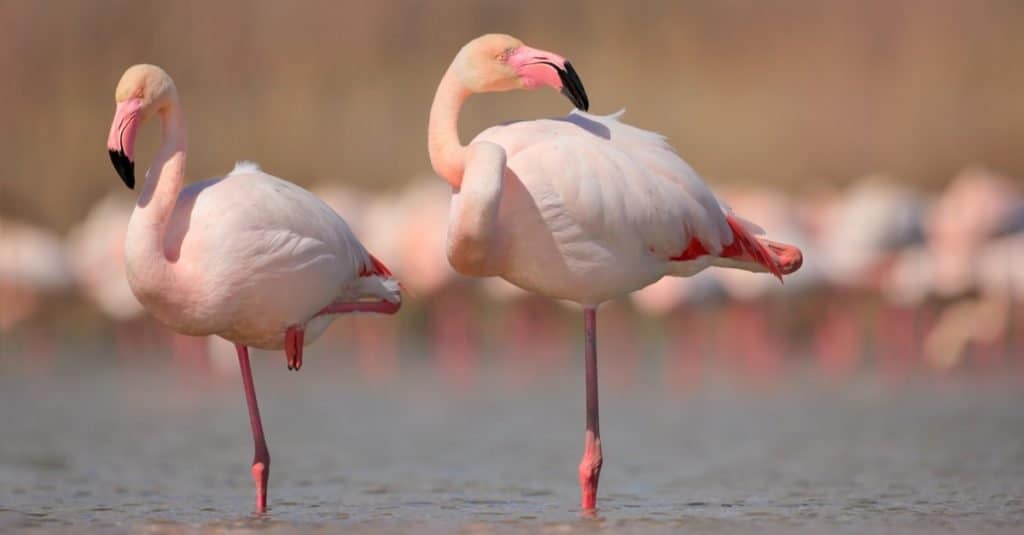
The bird’s legs help it to survive in its lagoon, lake, or swamp habitat.
©Ondrej Prosicky/Shutterstock.com
Diet
These birds are omnivores. One of the simplest facts to remember is they eat the food source that’s most plentiful in their habitat.
What eats them?
Some of the predators of these birds include eagles, vultures, kites, storks, raccoons, Geoffrey’s cats, feral pigs, and foxes. While adult birds are fairly safe in their colony, their eggs and hatchlings are targeted by these predators.
What do they eat?
This bird eats shrimp, snails, and algae. It dips its head into the water, turns it upside down, and eats small items of food by shoveling them into its upper beak.
Though most flamingos eat just 9 ounces of food per day, they drink around 4 gallons of water. Picture four, 1-gallon milk jugs in your refrigerator filled with water!
Check out this article about flamingo poop, and how the flamingo digestive system works.
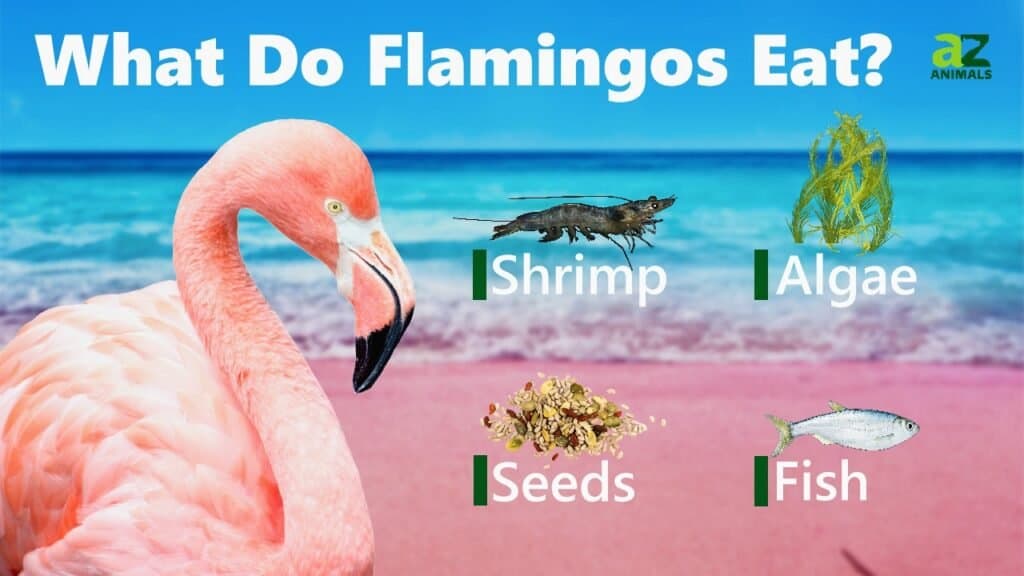
Predators and Threats
Some predators of these birds include vultures, eagles, storks, and kites. Foxes, Geoffrey’s cats, raccoons, and feral pigs are other predators of this bird and can steal eggs or hatchlings.
The birds in a colony watch over and defend one another’s eggs and hatchlings. Sometimes a predator will be discouraged from entering the area because there are so many birds in one colony.
Many of these birds live in lagoons and other bodies of water, so they’re vulnerable to water pollution created by nearby factories. Habitat loss due to construction is another threat.
The conservation status of this bird is Least Concern with an increasing population.
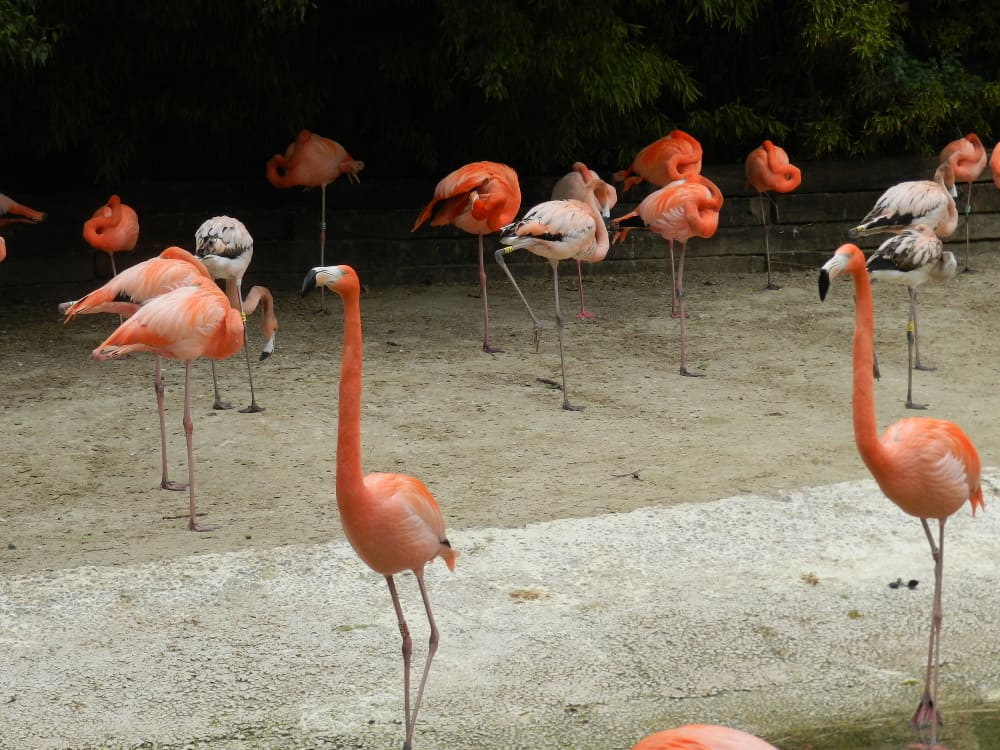
The birds in a colony watch over and defend one another’s eggs and hatchlings.
©Millie Bond – Copyright A-Z Animals
Reproduction, Babies, and Lifespan
There’s no specific time of year that these birds breed. However, the breeding time is the same throughout a flock or colony. That way, the chicks are born at the same time and can be raised together. Conditions such as the level of rainfall and the amount of food available to these birds can both influence when the breeding season takes place.
When breeding season arrives for a colony, the male flamingo struts around in front of females showing off and preening his feathers. Though these birds are thought to be monogamous, there are some males that mate with multiple females.
Flamingos build a nest that’s essentially a mound of mud with a shallow hole at its top. The female lays just one 5-ounce egg in the hole and both parents take turns keeping the egg warm until it hatches. The incubation period falls between 27 to 31 days. The White ibis bird which is similar to a flamingo has an incubation period of 21 days.
The baby or flamingo chick weighs around 3 ounces. Flamingo chicks are born with white downy feathers and a straight beak. A young flamingo’s feathers don’t come in fully pink until they reach the age of about 2 years old. Its beak begins to curve downward at about 11 weeks of age.
A chick stays with its parents for 5 days. The parents both feed the chick by releasing food from their stomachs into the chick’s mouth. Yuck! When the chick is 5 days old, it joins a small group of other chicks where it stays for three weeks. During this time, when the chick is hungry, the parents feed it. But how do the parents find their chick when it’s hanging around with other chicks? Answer: The parents find their chick by the sound of its peeps and honks.
After this three-week period, the parents move their chick to a larger group of other young flamingos where it learns to find food on its own. As you see, all birds in a flamingo colony play a part in raising young ones. Flamingos reach sexual maturity at 3 to 5 years old.
This bird can live from 20 to 30 years in the wild. Furthermore, they can live for 50 years or more in zoos. The oldest recorded flamingo lived to be 83!
Avian flu and tuberculosis (both respiratory issues) are common illnesses of the flamingo.
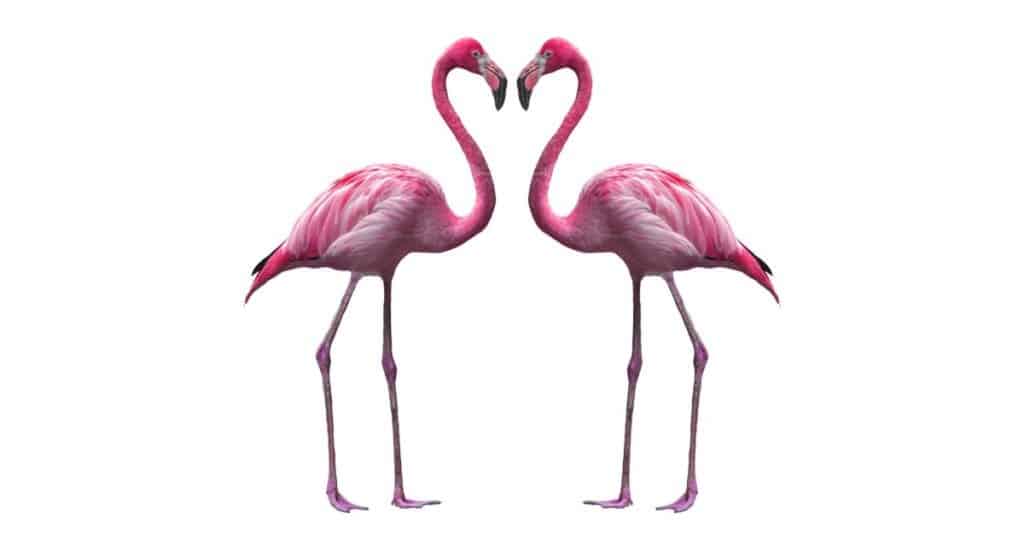
Though these birds are thought to be monogamous, there are some males that mate with multiple females.
©Independent birds/Shutterstock.com
Population
There are six species of flamingo and their populations vary. According to the IUCN Red List of Threatened Species:
- There are 260,000 to 330,000 mature American flamingos in the Turks and Caicos Islands
- The lesser flamingo has a population of 2,220,000 to 3,240,000 individuals. Some of these live in western and southern Africa while others are in southern Asia.
- The Chilean flamingo has a population of 300,000 in South America
- The greater flamingo has a population of 550,000 to 680,000 individuals in parts of Africa and Asia
- The population of the Andean flamingo is unclear but there are thought to be 11,600 individuals in South America
- The Puna flamingo population is estimated at 106,000 individuals in South America
Both the American and greater flamingos have a conservation status of Least Concern with an increasing population.
The lesser flamingo species along with the Chilean flamingo has a status of Near Threatened with a decreasing population.
The Andean flamingo has a status of Vulnerable with a decreasing population.
The Puna flamingo is Near Threatened with a population described as stable.
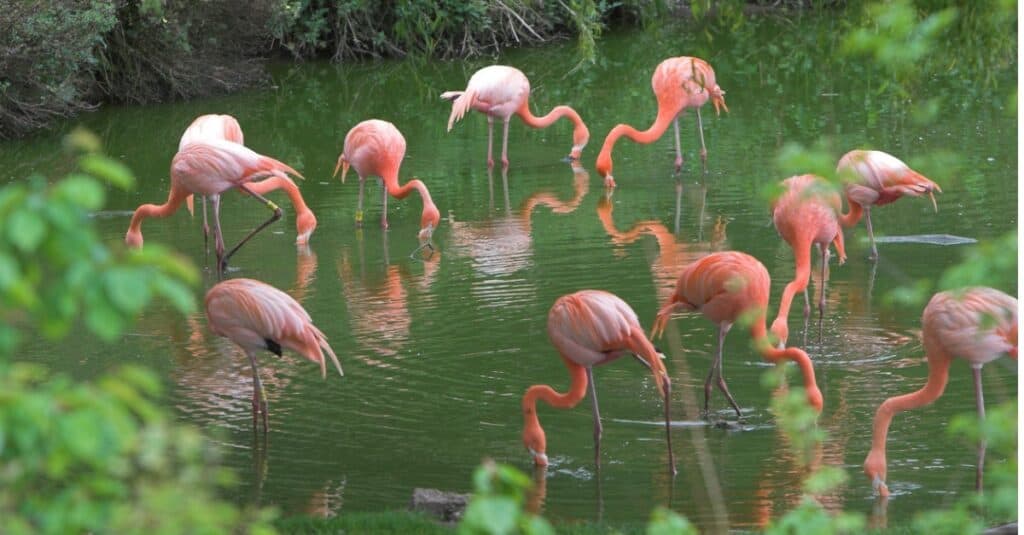
Both the American and greater flamingos have a conservation status of Least Concern with an increasing population.
©iStock.com/GTMedia
In the Zoo
- Discover beautiful flocks of flamingos at the San Diego Zoo
- Enjoy the exhibit of flamingos at the Indianapolis Zoo
- The Houston Zoo has a Chilean flamingo on display
Flamingo FAQs (Frequently Asked Questions)
Are Flamingos herbivores, carnivores, or omnivores?
Flamingos are Omnivores, meaning they eat both plants and other animals.
What Kingdom do Flamingos belong to?
Flamingos belong to the Kingdom Animalia.
What class do Flamingos belong to?
Flamingos belong to the class Aves.
What phylum to Flamingos belong to?
Flamingos belong to the phylum Chordata.
What family do Flamingos belong to?
Flamingos belong to the family Phoenicopteridae.
What order do Flamingos belong to?
Flamingos belong to the order Phoenicopteriformes.
What type of covering do Flamingos have?
Flamingos are covered in Feathers.
What genus do Flamingos belong to?
Flamingos belong to the genus Phoenicopterus.
In what type of habitat do Flamingos live?
Flamingos live in large lakes and plantless lagoons.
What is the main prey for Flamingos?
Flamingos eat algae, fish, and insects.
What are some predators of Flamingos?
Predators of Flamingos include humans, eagles, and wild dogs.
What are some distinguishing features of Flamingos?
Flamingos have long, curved beaks and sleep standing on one leg.
How many eggs do flamingos lay?
A flamingo lays just one egg that’s cared for by both the mother and father.
How fast do flamingos fly?
Flamingos can fly as fast as 37 mph!
What is the wingspan of a flamingo?
The wingspan of this bird goes up to 60 inches.
When do flamingos leave the nest?
Flamingo chicks leave the nest after just five days! They go to live in small groups with other young flamingos. But the chicks return to their parents whenever they’re hungry. After three weeks, the young flamingos go to live with another group of youngsters where they begin to find food on their own.
What is the lifespan of a Flamingo?
Flamingos can live for 15 to 30 years.
Thank you for reading! Have some feedback for us? Contact the AZ Animals editorial team.
Sources
- Flamingos World, Available here: https://www.flamingos-world.com/
- Wikipedia, Available here: https://en.wikipedia.org/wiki/Flamingo

